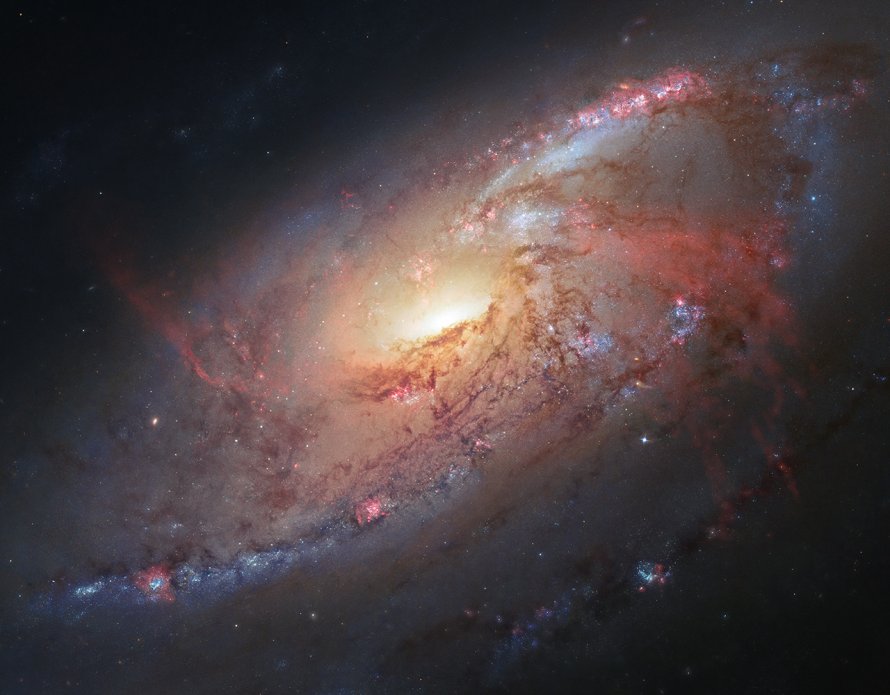M106 (NGC 4258)
Messier 106 (NGC 4258) is a spiral galaxy located in the constellation Canes Venatici in the CVn II Group of galaxies. M106 is 23700000 light years away from Earth.
M106 is best viewed during early spring, is magnitude 8.4, and can be viewed with binoculars. M106 is 18.6' x 7.2' in apparent size. For reference, the full moon is 30'.
Observing difficulty: Hard
- Name:
- Type:
- spiral galaxy
- Constellation:
- Canes Venatici
- NGC or IC:
- NGC 4258
- Magnitude:
- 8.4
- Viewing:
- binoculars
- Size:
- 18.6' x 7.2'
- Distance (light years):
- 23700000 LY
- RA:
- 12h 18.9m
- Dec:
- 47 19'
- Season:
- early spring
- Galaxy group:
- CVn II Group
- Messier Marathon #:
- 40
* The naked eye can see up to magnitude ~7-8 objects under ideal dark sky conditions.
An Intermediate Spiral Galaxy
Messier 106 (M106) is an intermediate spiral galaxy located in the constellation Canes Venatici, "The Hunting Dogs". It was discovered by Pierre M?chain, a French astronomer and colleague of Charles Messier, in 1781. While not included in the original Messier catalogue, it was added to the list in the 20th century.
Characteristics of Messier 106
M106 is classified as an intermediate spiral galaxy, meaning that it exhibits properties of both unbarred and barred spiral galaxies. It is notable for its well-defined spiral arms, filled with many hot, young, blue stars and pinkish areas that denote regions of active star formation. The galaxy also hosts a supermassive black hole at its center, which is believed to be responsible for the unusual structure of its arms.
One of the remarkable features of M106 is its anomalous arms. Unlike most spiral galaxies that have two main arms, M106 has an additional set of arms, which are made up of hot gas and appear bright in radio and X-ray observations. These anomalous arms are believed to be the result of the supermassive black hole at the galaxy's center, which creates powerful jets of high-energy particles.
Magnitude and Distance
Messier 106 is relatively nearby in cosmic terms, situated approximately 24 million light-years away from Earth. With an apparent magnitude of 8.4, it is one of the brightest and largest galaxies that is not included in the Messier's original list. It is an intriguing target for astronomers due to its active galactic nucleus and the atypical structure of its arms.
Finding and Observing Messier 106
M106 is located in the constellation Canes Venatici, which is visible in the northern hemisphere from spring through summer. The galaxy can be found southeast of the Plough or Big Dipper, a well-known asterism in the larger constellation Ursa Major. It lies near the border with the constellation Ursa Major and is found south of the star Phecda (Gamma Ursae Majoris) in the bowl of the Big Dipper.
Although it's possible to view M106 with binoculars under excellent dark-sky conditions, a small telescope will offer a better view, revealing the galaxy as a faint patch of light with a brighter center. Larger amateur telescopes will begin to reveal some structure and texture, especially the bright nucleus and the galaxy's mottled spiral arms.
M106 remains a subject of interest for both professional and amateur astronomers due to its unique characteristics. Its relative brightness and proximity to our own Milky Way galaxy make it an excellent target for astrophotography and scientific study.



